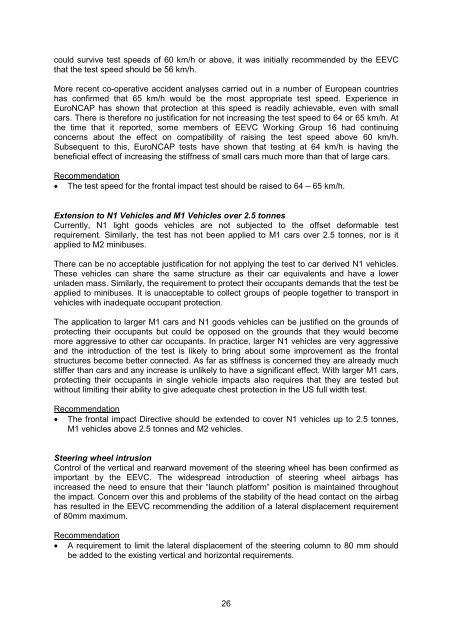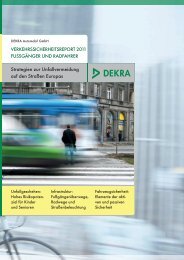PRIORITIES FOR EU MOTOR VEHICLE SAFETY DESIGN
priorities for eu motor vehicle safety design - ETSC
priorities for eu motor vehicle safety design - ETSC
You also want an ePaper? Increase the reach of your titles
YUMPU automatically turns print PDFs into web optimized ePapers that Google loves.
could survive test speeds of 60 km/h or above, it was initially recommended by the EEVC<br />
that the test speed should be 56 km/h.<br />
More recent co-operative accident analyses carried out in a number of European countries<br />
has confirmed that 65 km/h would be the most appropriate test speed. Experience in<br />
EuroNCAP has shown that protection at this speed is readily achievable, even with small<br />
cars. There is therefore no justification for not increasing the test speed to 64 or 65 km/h. At<br />
the time that it reported, some members of EEVC Working Group 16 had continuing<br />
concerns about the effect on compatibility of raising the test speed above 60 km/h.<br />
Subsequent to this, EuroNCAP tests have shown that testing at 64 km/h is having the<br />
beneficial effect of increasing the stiffness of small cars much more than that of large cars.<br />
Recommendation<br />
• The test speed for the frontal impact test should be raised to 64 – 65 km/h.<br />
Extension to N1 Vehicles and M1 Vehicles over 2.5 tonnes<br />
Currently, N1 light goods vehicles are not subjected to the offset deformable test<br />
requirement. Similarly, the test has not been applied to M1 cars over 2.5 tonnes, nor is it<br />
applied to M2 minibuses.<br />
There can be no acceptable justification for not applying the test to car derived N1 vehicles.<br />
These vehicles can share the same structure as their car equivalents and have a lower<br />
unladen mass. Similarly, the requirement to protect their occupants demands that the test be<br />
applied to minibuses. It is unacceptable to collect groups of people together to transport in<br />
vehicles with inadequate occupant protection.<br />
The application to larger M1 cars and N1 goods vehicles can be justified on the grounds of<br />
protecting their occupants but could be opposed on the grounds that they would become<br />
more aggressive to other car occupants. In practice, larger N1 vehicles are very aggressive<br />
and the introduction of the test is likely to bring about some improvement as the frontal<br />
structures become better connected. As far as stiffness is concerned they are already much<br />
stiffer than cars and any increase is unlikely to have a significant effect. With larger M1 cars,<br />
protecting their occupants in single vehicle impacts also requires that they are tested but<br />
without limiting their ability to give adequate chest protection in the US full width test.<br />
Recommendation<br />
• The frontal impact Directive should be extended to cover N1 vehicles up to 2.5 tonnes,<br />
M1 vehicles above 2.5 tonnes and M2 vehicles.<br />
Steering wheel intrusion<br />
Control of the vertical and rearward movement of the steering wheel has been confirmed as<br />
important by the EEVC. The widespread introduction of steering wheel airbags has<br />
increased the need to ensure that their “launch platform” position is maintained throughout<br />
the impact. Concern over this and problems of the stability of the head contact on the airbag<br />
has resulted in the EEVC recommending the addition of a lateral displacement requirement<br />
of 80mm maximum.<br />
Recommendation<br />
• A requirement to limit the lateral displacement of the steering column to 80 mm should<br />
be added to the existing vertical and horizontal requirements.<br />
26



